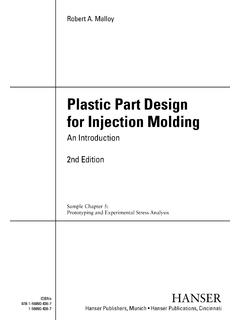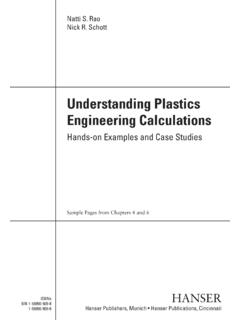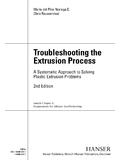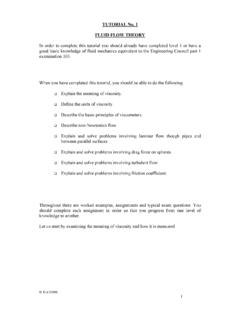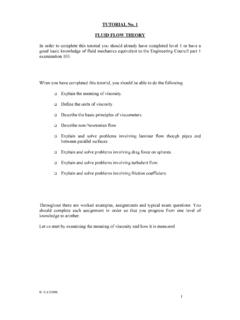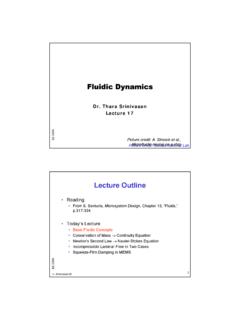Transcription of Polymer Rheology - hanserpublications.com
1 Polymer RheologyFundamentals and Applica onsTim A. OsswaldNatalie RudolphBook ISBN978-1-56990-517-3 HANSER Hanser Publishers, Munich Hanser Publica ons, Cincinna Contents, Preface, Sample Pages, Subject IndexContentsDedication ..VPreface ..VII1 Introduction to Rheology .. The Field of Rheology .. Viscous Liquids or the Newtonian Fluid .. Linear Elasticity or the Hookean Spring .. Viscoelasticity and the Maxwell Model .. Time Scale and the Deborah Deformation, Rate of Deformation, and the Deviatoric Stress Guide to the Book ..20 Problems ..21 References ..212 Structure and Properties of Deforming Polymers .. Molecular Structure of Polymers .. Stress Relaxation Behavior .. Shear Thinning Behavior .. Normal Stresses in Shear Flow .. Stress Overshoot during Start-up Flow.
2 Melt Strength or Melt Fracture .. Dynamic Response ..47 Problems ..56 References ..573 Generalized Newtonian Fluid (GNF) Models .. Temperature Dependence of viscosity .. Viscous Flow Models .. The Power Law Model .. The Bird-Carreau-Yasuda Model ..68X The Cross-WLF Model .. The Bingham Model .. The Herschel-Bulkley Model .. Accounting for Pressure Dependence in Viscous Flow Models . Power Law .. Carreau-WLF .. Cross-WLF .. Universal Temperature and Pressure Invariant viscosity Function .. Elongational viscosity .. Suspension Rheology .. Chemo- Rheology ..87 Problems ..95 References ..974 Transport Phenomena .. Dimensionless Groups .. Balance Equations .. The Mass Balance or Continuity Equation .. The Material or Substantial Derivative.
3 The Momentum Balance or Equation of Motion .. The Energy Balance or Equation of Energy .. Model Simplification .. Reduction in Dimensionality .. Lubrication Approximation .. Viscometric Flows .. Pressure Driven Flow of a Newtonian Fluid through a Slit .. Flow of a Power Law Fluid in a Straight Circular Tube (Hagen-Poiseuille Equation) .. Volumetric Flow Rate of a Power Law Fluid in Axial Annular Flow .. Circular Annular Couette Flow of a Power Law Fluid .. Squeezing Flow of a Newtonian Fluid between Two Parallel Circular Discs .. Flow of a Power Law Fluid between Two Parallel Circular Discs ..137 Problems ..140 References ..141XI Contents5 Viscoelasticity .. Linear Viscoelasticity .. Relaxation Modulus .. The Boltzmann Superposition Principle.
4 The Maxwell Model Relaxation .. Kelvin Model .. Jeffrey s Model .. Standard Linear Solid Model .. The Generalized Maxwell Model .. Dynamic Tests .. Non-Linear Viscoelasticity .. Objectivity .. Differential Viscoelastic Integral Viscoelastic Models ..179 References ..1846 Rheometry .. The Sliding Plate Rheometer .. The Cone-Plate Rheometer .. The Parallel-Plate Rheometer .. The Capillary Rheometer .. Computing viscosity Using the Bagley and Weissenberg-Rabinowitsch Equations .. viscosity Approximation Using the Representative viscosity Method .. The Melt Flow Indexer .. Extensional Rheometry .. High Pressure Rheometers .. Integrated Mold Sensors for Quality Control ..214 Problems ..217 References ..218 Subject Index.
5 221 PrefaceDesigned to provide a Polymer Rheology background to both engineering students and practicing engineers, this book is written at an intermediate level with the technical information and practical examples required to enable the reader to understand the complex rheological behavior of polymers and its far-reaching consequences. It also provides the necessary decision-making tools for the appropriate choice of rheological testing methods, and the means to troubleshoot Rheology related problems encoun-tered in Polymer processing. The organization of Polymer Rheology Fundamentals and Applications and the practical examples throughout the book make it an ideal textbook and reference book, and the information provided is particularly valuable to processors and raw materials authors would like to acknowledge the invaluable help of many during the prepa-ration of this manuscript: our colleagues at the Polymer Engineering Center at the University of Wisconsin-Madison and at the Institute for Polymer Technology at the Friedrich-Alexander-University in Erlangen, Germany.
6 In particular we would like to thank Dr. Andrew Schmalzer for serving as a sounding board and for his input, John Puentes for helping with the example problems in Chapter 4, Chuanchom Aumnate for the measurements used in the examples in Chapters 2 and 5, and Camilo Perez for reviewing Chapter 3. We are grateful to Tobias Mattner for his outstanding job in not only drawing the figures, but also making excellent suggestions on how to more clearly present the information. Thanks are due to Dr. Christine Strohm for her valuable expertise in editing this book. Dr. Nadine Warkotsch, Dr. Mark Smith and J rg Strohbach of Carl Hanser Verlag in Munich are thanked for their support throughout this project. Above all, the authors would like to thank their families for their continued support of their work and their input throughout the writing of this 2014 Tim Osswald and Natalie Rudolph Madison, Wisconsin, Viscous Liquids or the Newtonian FluidBACcab(Hookean solid)ElasticityViscosity(Newtownian fluid) solid or Pascalian fluidSteady state flow of a Newtonian fluida.
7 Kinetic energyb .. Elastic or stored energyc .. Dissipated or lost energyFigure Rheological energy in triangular coordinates Viscous Liquids or the Newtonian FluidSir Isaac Newton (Fig. ) was the first person to formulate a hypothesis that described the resistance to motion experienced by deforming fluids. In 1686 he published this work in Philosophi Naturalis Principia Mathematica [4] in a chapter titled On the Circular Motion of Liquids . His hypothesis clearly states what we know today as a characterictic of a Newtonian fluid2:That the resistance which arises from the lack of slipperiness of the parts of the fluid, other things being equal, is proportional to the velocity with which the parts of the liquid are separated from one phenomenon, described by Newton as defectu lubricitatis, or lack of slipperi-ness between two fluid particles, was attributed to attritus, meaning internal friction, or viscous friction.
8 Since that time, the term internal friction and viscous friction have been used interchangeably. Although Newton s original work contains a mistake, corrected by Sir George Stokes [3] 150 years later, his main conclusion is still correct; it basically states that the force F required to maintain the motion between two fluid planes located at two arbitrary positions, say C and D in Newton s diagram (Fig. ), is proportional to the difference between the velocity, u, of the 2 The authors are using Emil Hatschek s translation from the Latin [2].81 Introduction to Rheologytwo planes, and inversely proportional to the distance, r, between those two surfaces, the viscosity , , and the area of the surfaces that separates them, A,3 = dcDCuuFArr ( )3 Newton used upper case A, B, C, D, etc.
9 To describe the position of the surfaces, and lower case a, b, c, d, etc. to describe the velocity of those Sir Isaac Newton (1643 1727), painted in 1689 by Sir Godfrey KnellerFigure Diagram from Newton s 1686 publication [2] Viscous Liquids or the Newtonian FluidFAh FluidxyuFigure Simple shear flow with Cartesian coordinatesAs shown in Newton s diagram, his analysis pertained to a rotating cylinder immersed in an infinitely large fluid body. For a more simplified system, such as the simple shear flow generated between two parallel plates presented in Fig. , Equation can be expressed in terms of shear stress, and written as =uFAh ( )ort g= xyxy ( )where txy is the shear stress in the x direction on a plane with its normal direction pointing in the y direction, and g xy is the corresponding rate of shear, or rate of deformation.
10 The stress (here txy) that leads to the deformation of the fluid contained within the system is also often referred to as the deviatoric Newtonian model, or the viscous component of a material, is often also repre-sented using a dashpot, shown in Fig. tht+ t xy xy xFigure The dashpot a schematic representation of a Newtonian fluid4 As will be shown in Chapter 2, which covers flow, the total stress, , is divided into the deviatoric stress compo-nent, t, which causes deformation, and the hydrostatic stress component, which results from pressure, Introduction to RheologyWhile the schematic representation in Fig. reflects an elongational deforma-tion along the x-axis, the dashpot can also be used for shear deformation, which is written asgD=xyxh ( )Figure also shows that the deformation is time dependent and, in the case of a Newtonian fluid, the dependence between deformation and time is linear.




